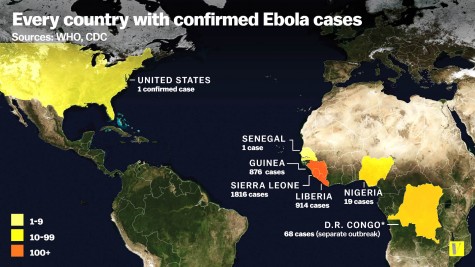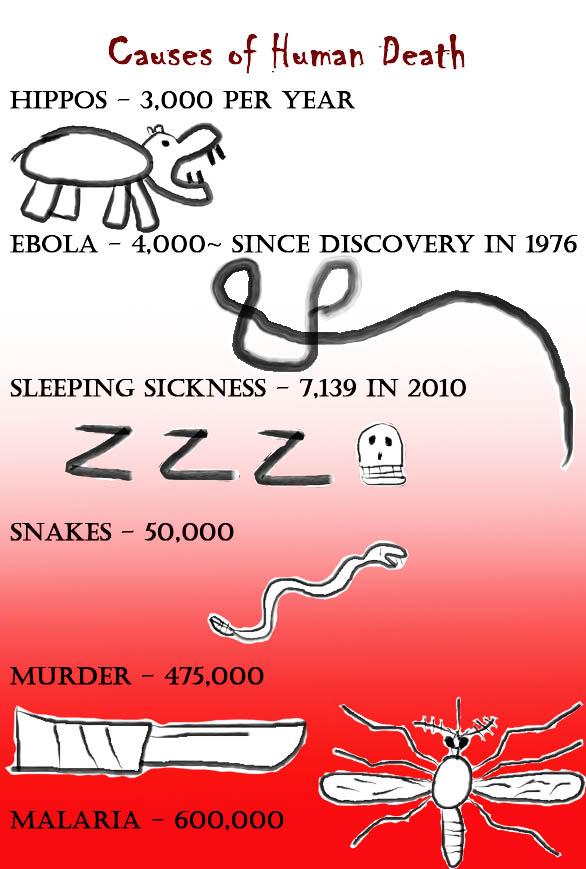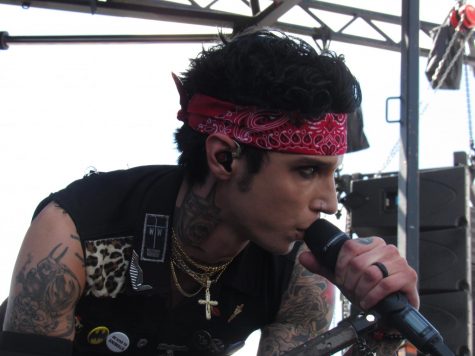Ebola comes to America
A look at what kills more humans annually.
It came from Liberia. The virus that threatens to drown us in our own blood and end the thousands of years of human existence. Ebola has landed in the United States. Surely a pandemic of this scale will take America like a firestorm and reduce us to dust.
Not really. Ebola is an epidemic in that it has spread to other countries, but it remains primarily in Africa. So far, Ebola has a recorded kill count of about 4,000 people, since its discovery in 1976. It is true that over half of those treated in this one outbreak have died, but let’s compare that to some real killers.
The most dangerous, large mammal in Africa is the hippo, killing almost 3,000 people a year. That’s because every year 3,000 unlucky people find out that hippos can run 20 miles an hour. Worldwide, scorpions kill around 5,000 people, and there are only 25 species of scorpions that are deadly.
Want another reason to hate snakes? How about the stat that 50,000 people die from snakebites a year, giving snakes the title of the most deadly reptile. Want a reason to not hate snakes? They are great pets and love to cuddle, just buy the right kind.
But if we really want to talk about killers, let’s talk about the Tsetse fly. It carries the African sleeping sickness and used to infect 300,000 people a year, while feeding, killing 80 percent infected. That number has dropped thanks to control efforts, with only 7,139 cases in 2010. The parasite enters the body and works its way into the central nervous system after months or years, eventually causing coma and death.
Another bloodsucker is twice as deadly, and the most deadly animal in the world beside humans. The primary agent of malaria in Africa is the mosquito.
We kill a measly 475,000 humans a year, not counting war casualties. Every year, 600,000 people die from malaria, a curable disease. Malaria kills by inducing coma, inflaming the lungs, shutting down kidneys and destroying red blood cells.
Ebola was stopped in Nigeria using the Centers for Disease Control contact tracing technique. They found the people who victims contacted, monitored them, and quarantined them and treated the virus. A country dealing with government corruption, malaria, sleeping sickness, local terrorists, and an illiteracy rate of 40 percent, stopped Ebola with 19 cases.
If you want an accurate picture of Ebola in the U.S., think of it like this: more people have been married to Britney Spears than have died of Ebola. The mortality rate of Ebola in the U.S. is 33 percent, a third of the three people infected have died. As long as you don’t go around getting blood on you, there isn’t much of a risk here.

A geographical look of the spread of Ebola worldwide.
A Washington Post poll found that 65 percent of Americans are concerned about Ebola becoming widespread. It’s true that the response hasn’t been great. Now we have a “Czar” for Ebola and a “strike team” to hunt down the infected.
But we need to start at the medical level. There’s no reason our health care workers should be infected with the medical equipment we have. But mistakes happen, and these mistakes can cause people to bleed uncontrollably.
With our fast paced spread of information today, we can whip millions into hysteria faster than ever. It used to take months to let everyone know that the Plague is caused by the Devil and that posies would protect the righteous. Now we can tell all of our followers that Ebola will become airborne with one tweet.
I’m not saying don’t worry about Ebola. It is a serious disease that kills half of whoever it infects.
But you should probably spend that energy worrying about something more realistic, like the impending zombie plague caused by an Amazon fungus.

Alexander Rose is a Managing Editor of The Hawkeye.
Alex was born in Tampa, Florida. He lived in Honduras for four years then moved to Brooksville...












Ron Swanson • Mar 17, 2015 at 2:32 pm
“Merica, God Bless.